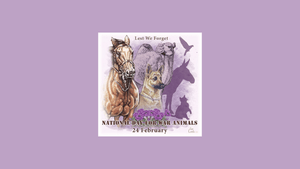National Day for War Animals
The 24th of February is the National Day for War Animals, a day where we commemorate the deeds and sacrifices of animals in war.

Image Credit, above and cover - Ian Coate
Animals have been put to many uses in war, serving as transport, beasts of burden, messengers, protectors, mascots, and pets and Australia has a rich history when it comes to the use of animals in war. From horses and dogs to pigeons and, of course, camels, these animals played an important role in supporting the efforts of Australian troops during times of conflict.

While the donkey made famous by Simpson is perhaps the best-known example of a beast of burden, one of the most notable animals in Australian military history is the camel. Camels were first introduced to Australia in the mid-1800s, as a means of transportation for early explorers and settlers. These hardy animals were well-suited to the harsh Australian outback, and they were quickly put to use by the Australian military during times of war.

Battle of Magdhaba
Camels were first used by the Australian military during the Second Boer War (1899-1902), when the British Army requested the assistance of Australian camel handlers to transport supplies across the South African desert.
During World War I, Camels continued to be used by the Australian Military to transport supplies, as well as to carry wounded soldiers.

The Imperial Camel Corps, a camel-mounted infantry brigade, was raised in January 1916 and was attached to the Anzac Mounted Division, and therefore Harry Chauvel, who commanded the whole division.

Imperial Camel Corps Badge
The brigade had one battalion each from Great Britain and New Zealand, and two from Australia. It started small but eventually grew to a strength of 3380 men and 3880 camels -500 more camels than men.

The battalions of the ICC fought alongside Australian light horse units at Beersheba, Romani, Magdhaba and Rafa, and remained an integral part of the force that advanced north through Palestine in 1917 and 1918.
Following World War I the use of camels by the Australian military declined significantly, although they are still used in an honorary fashion. Based at Amberley, The 26 Transport Squadron’s mascot is the camel so they have two camels, Penny and Vernon. From time to time, Penny and Vernon have a ‘holiday’ at Summer Land Camels, where they get to make new camel friends and hang out with our crew.

Penny & Vernon, 26 Transport Squadron
We also provide training. As is the nature of the military, their camel handlers might get moved, or get a promotion so they come to us to upskill the new handlers for the job.

Today, the role of camels in Australian military history is largely forgotten, but it is important to remember the contributions that these hardy animals made to the country's wartime efforts.
The legacy of the Australian War Animals, including camels, should never be forgotten.


